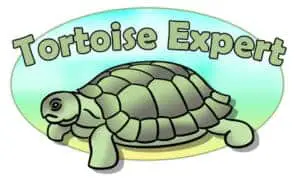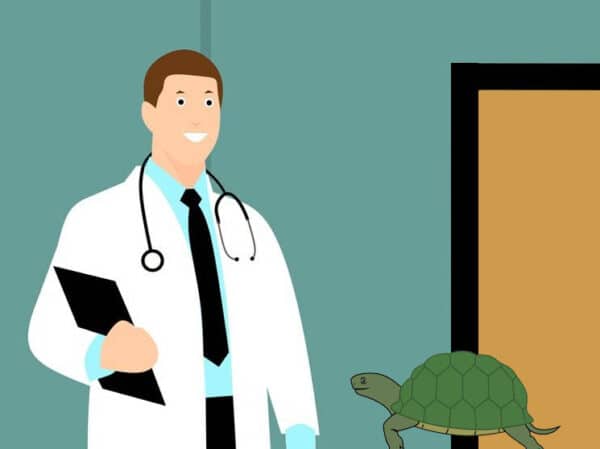Vent prolapse occurs when either a sex organ or an internal organ is noticeable outside the cloaca or ‘vent’ of a tortoise. Diarrhea, infection, intestinal parasites, hypocalcemia, bladder stones, trauma/injury, or impaction are some of the possible causes. The condition can be successfully treated by a veterinarian.
A tortoise may deal with multiple conditions throughout its life, and perhaps one of the most unpleasant of them is vent prolapse.
Vent prolapse is a very common problem, and it doesn’t only happen to those who are new to caring for tortoises or those keeping tortoises in improper environments. Even those who are experienced with tortoise husbandry encounter this issue.
Prolapse can be very dangerous, indeed if the issue lasts for too long, then it can threaten the tortoise’s life. So, you should take action as soon as you notice any symptoms. But what exactly is tortoise vent prolapse, and how do you treat it? Read on to find out!
What Is Tortoise Vent Prolapse?
Vent prolapse in tortoises is very common. When an organ of the tortoise, whether a sex organ or an internal organ from within the body cavity can be observed outside the vent of the tortoise., that is characterised as a prolapse.
Different organs can be pushed, by accident, through the vent opening, or they can simply fall out. Unless the reptile is a breeding female, there is no reason for this to happen, and it can actually be extremely dangerous.
You will be able to see something fleshy protruding from the tortoise’s vent, so it’s a condition that can be easily observed and diagnosed.
Why Does It Happen?
Vent prolapse may happen for several reasons. An infection may be the culprit, but it might also be caused by diarrhea, intestinal parasites, hypocalcemia, or bladder stones. Injury may also lead to this problem, as well as impaction due to eating gravel, pebbles, or other ‘non-foods’.
Also, if a tortoise is separated by force during copulation, this may result vent prolapse.
For female tortoises, egg binding (when an egg gets stuck or takes longer to pass through the reproductive tract) might be the cause, so this is arguably an unavoidable cause of prolapse.
Basically anything that puts undue pressure on the colon and end of the digestive tract is a risk factor.
How Is It Treated?
If your tortoise is suffering with a prolapsed vent, you need to take immediate action, especially if the tortoise is not breeding, and the prolapse has been going for more than a few hours. The longer you let your tortoise endure it, the worse it’ll be, and it’s never a good idea to wait too long with any ailment.
First of all, make sure you don’t try treating it at home by yourself. Despite the information available on the subject, treating a tortoise for vent prolapse yourself might do more harm than good. What you should do instead is take it to a veterinarian.
The correct course of action here is crucial to avoid further complications. For instance, when prolapsed, the internal tissue becomes necrotic. The longer you wait, the more permanent damage there will be to the tissue, and infection is also prone to happen.
After setting up a vet appointment, what you can do in the meantime is bathe the tortoise in sugar water to relieve some of the discomfort. This can help relieve swelling. If the prolapse is not severe, sugar water may help the prolapse fix itself, but you shouldn’t rely on this. Always take the tortoise to the vet when you see this issue.
The tortoise may be sedated by the veterinarian in order to clean and lubricate the area, as well as perform the tissue replacement. They will then start suturing (stitching) the vent in order to prevent prolapse from happening again in future. In case of any necrotic tissue, this will likely have to be removed.
In some cases, the vent may also have to be enlarged with an incision. This procedure is selected when it’s not possible to replace the tissue without a larger opening.
Any exposed internal organs will also be replaced in the right position where necessary.
Following the procedure, the tortoise will be given antibiotics to combat any opportunistic bacterial infection.
In specific situations such as when a prolapse is due to egg binding or constipation, there will be an x-ray taken. Blood tests or stool samples will be taken only if there are parasitic infections, dietary imbalance, or any type of foreign body infection.
If there is an underlying infection or other issue that is suspected of leading to the prolapse, the veterinarian will also treat this.
Prognosis
You will either be able to take the tortoise home after the procedure, or they will have to stay at the vet clinic for a few days to be closely monitored. It all depends on how severe the case is.
If no complications occur following the tissue reduction/replacement, the tortoise should recover normally. In any case, you should keep an eye on it, just to make sure nothing untoward happens. Even if your tortoise had tissue necrosis and the vet had to amputate part of the prolapsed tissue, there is still a very high chance of a positive prognosis.
How Can You Avoid Tortoise Vent Prolapse?
You can prevent tortoise vent prolapse if you take proper care of your tortoise and pay attention to its behaviour.
For instance, you should monitor the number of times your tortoise defecates. If it’s too infrequent, constipation may be the issue, and you should take action to stop it before it causes vent prolapse.
You should also pay close attention to diet. If you have any concerns, add some mineral oil, pumpkin, and watermelon to the diet for several days. The pet should also have fresh drinking water available at all times.
Conversely, diarrhea is also a common issue that can lead to prolapse, so if this is a recurring issue you should once again aim to fix the tortoise’s diet to stop it, and if necessary, take it to the vet for further treatment.
Never separate tortoises when they’re mating. This could also lead to prolapse. There is no reason to separate them, not least because it’s a natural, and indeed necessary, phenomenon.
You should also prevent diseases by maintaining high standards of hygiene in the tortoise’s enclosure.
Final Thoughts
Tortoise vent prolapse is a serious condition and it should never be ignored, doing so will only lead to unecessary suffering, perhaps leading to complications, and sometimes even death.
When you notice what you suspect to be a prolapse, schedule an appointment with the vet so your pet can be cared for as soon as possible.


